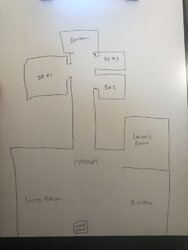Hi there guys My name is Derek. New to this forum page and first time homeowner! We have a wood stove and love it. A little outdated it’s an old Schrader fireplace lol. Ordered a new Quadra fire stove so we’ll see how that goes. But I wanted to ask if there is anyone that has a solution to getting the heat into the rooms with the doors closed. I will attach a rough sketch of my floor plan. I’d like to be able to close the doors at night and still be able to get some heat in the bedrooms. They get too cold at night if not. I will be getting the crawl space better insulated as well and windows. Thanks in advance!




